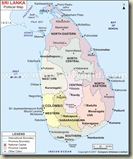 And why not? They have a lot of it:
And why not? They have a lot of it:
Vitharana had told the newspaper that Sri Lanka had Thorium deposits in the Western coast of the island from Beruwala to Negombo, which is an areas stretching South and North of the capital, Colombo.
What they don't have is the technology to use it, but luckily their neighbors to the north, also with piles of the stuff, is trying to make it plausible:
"The Indians have developed a technology to enrich Thorium as a source of energy to produce electricity," minister Vitharana was quoted as saying. "They are on the verge of commissioning a reactor for power generation in India using Thorium as main resource."
This is all at the chatter level - literally, with Sri Lanka and India broaching the subject at the IAEA's annual conference - and pretty abstract - Thorium has gotten over some impressive technical hurdles, but there are other issues to consider, especially:
- the high cost of fuel fabrication, due partly to the high radioactivity of U-233 chemically separated from the irradiated thorium fuel. Separated U-233 is always contaminated with traces of U-232 (69 year half life but whose daughter products such as thallium-208 are strong gamma emitters with very short half lives);
- the similar problems in recycling thorium itself due to highly radioactive Th-228 (an alpha emitter with two-year half life) present;
- some weapons proliferation risk of U-233 (if it could be separated on its own); and
- the technical problems (not yet satisfactorily solved) in reprocessing solid fuels.
Where thorium represents an opportunity - and, as noted in a post below, come to the attention of the American government via high-profile legislation - is its abundance, estimated to be three times that of uranium (about on par with lead) and perhaps even more - the element's relative lack of utility has constrained any major search for veins.
---
About that legislation. This popped out at us amongst its findings:
((6)(A) thorium fuel cycle technology was originally developed in the United States; and (B) cutting-edge research relating to thorium fuel cycle technology continues to be carried out by entities in the United States.
Not untrue, but odd to note this as a bona fide. Would its value be less if the French got there first?
Map of Sri Lanka. Since the country has held itself aloof from entities like The World Bank and International Monetary Fund - to its credit, perhaps? - the money to build a plant might be hard to come by. A thorium plant is, no matter how you slice it, capital intensive. Then again, the value of thorium itself may pick up considerably.
Comments
Fluoride reactor technology is the key to the successful utilization of thorium.
A much smarter way of using Thorium would be in fast reactors or in molten salt reactors, through internal chemical reprocessing.
This is essentially the way to go.
Once the technology for internal reprocessing is operational, we don't need any enrichment even for Uranium. This drastically simplifies the task of IAEA in enforcing anti-proliferation safeguards.
This is the future for nuclear power. And the technologies are already here, even commercial designs. What is lacking is will to take the plunge.
It is a shame that USA is leaving this task undone, and looking toward India, Russia and Japan to finish this business.
This inaction will be a serious strategic blunder and technological loss for the USA. The Integral Fast Reactor project should be revived immediately. So should be revived the molten salt reactor project, which was abandoned after the aircraft reactor experiment.
some weapons proliferation risk of U-233 (if it could be separated on its own)
Anyone sophisticated enough to produce and then separate U-233 for a weapon would already be sophisticated enough to separate U-235 and U-238 in natural uranium, thus bypassing all the bother of producing U-233 in the first place.